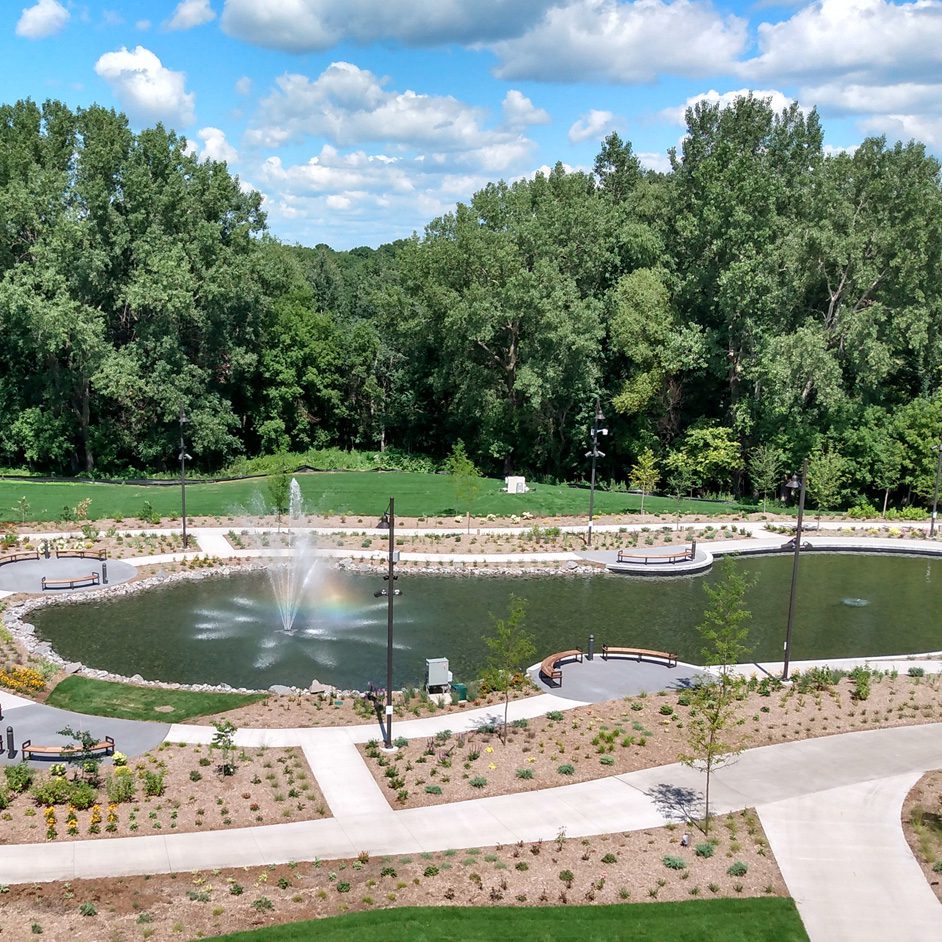
Climate change is reshaping precipitation patterns — and impacting site design at LHB. Storms are less frequent but tend to be more intense, delivering higher volumes of rain in shorter periods. The sudden influx of runoff from such storms can wreak havoc on a site, resulting in floods, property damage, and wetland degradation if not channeled or contained correctly.
In response, management of stormwater has become a key concern for city officials and civil engineers looking to safeguard property and communities. LHB’s civil team has always addressed stormwater management in its design of sites, but the matter has escalated in importance in recent years as concerns about massive storms and flooding have mounted. Resiliency is a priority among owners and communities.
Every site design project is unique, reflecting its specific landscape, of course, but LHB’s civil team always begins the design process by asking several key questions related to stormwater. The questions include:
What do local governments and watershed districts require?
Stormwater management begins with understanding the regulations set by local municipalities and watershed organizations. Each city has specific requirements designed to protect water quality, manage runoff, reduce flooding risks, and protect wetlands from degradation. In recent years, many cities and watershed districts have tightened rules on how much water — if any — can leave the site. The condition of the runoff is also closely monitored and regulated, to prevent pollution from spreading.

What are the soil conditions?
Soil makeup affects infiltration capacity, the rate at which water can percolate through the ground. Sandy soils typically allow for rapid infiltration, while clay soils can significantly slow it, increasing the risk of surface runoff. (Our team often encounters clay soils while working around Duluth.) Before designing stormwater management systems, LHB engineers conduct soil tests to determine soil type and permeability. This information is vital for creating systems that work with, rather than against, the natural landscape. Good soils provide effective drainage, reducing the likelihood of flooding.
Are the soils contaminated?
Contamination on a site, often caused by industrial use, presents unique challenges in stormwater management. The stormwater leaches into contaminated soils, further mobilizing the contaminants deeper into the soil column. This process can ultimately impact the water table, compromising water quality and potentially harming ecosystems. Before a stormwater system can be implemented, our team must work alongside an environmental engineering consultant to develop and implement remediation strategies, ranging from excavation to treatment. If contaminants are below a certain threshold, however, methods like vegetated swales or sedimentation basins can be used to help filter out pollutants.
What is the size of your site?
Engineers calculate expected runoff volume based on local rainfall data, watershed characteristics, and land use. (Parking lots with impervious surfaces, for example, can significantly increase the amount of runoff from a site, while simultaneously reducing the square footage of open land available for infiltration, swales, retention basins, and other stormwater management interventions.) Because property owners often wish to maximize the buildable square footage on their sites, room for stormwater handling is often at a premium. In such cases, drainage ponds are usually placed at the edges of sites, and filtration tanks may be hidden from view altogether. In our work at Bobby Theisen Park in Shoreview, for example, filtration tanks were installed below ground beneath the pickleball court to reduce overall space needs.
What kind of filtration is required?
When clean water percolates into the ground, it reduces surface runoff and replenishes groundwater supplies. To ensure effective absorption, our engineering team designs treatment systems that are tailored to the site’s specific soil conditions and hydrology. For example, to handle stormwater on a site for a retail client in Hermantown, Minn., where soils tended to impede infiltration, our team designed below-grade concrete holding tanks that contain specially designed filters to remove phosphorus and suspended solids.

What are the potential impacts on the sewer/stormwater system?
Connecting stormwater and sanitary sewers was a previous practice that is no longer done in design, but systems like this do still exist in some areas. In those situations, during heavy rainfall, overflow may result in the discharge of untreated sewage if the neighborhood’s stormwater and sewer systems are connected. Whenever possible, our design team advocates the use of rain gardens, permeable pavements, and bioswales to reduce the volume of stormwater entering sewer systems. Such solutions ensure sewer systems remain functional even during high-volume events — and public health isn’t threatened.
Dealing with stormwater can be challenging — nobody can forecast exactly what’s to come, weatherwise. But we believe a proactive approach to stormwater management can mitigate the impacts of climate change, ensuring a resilient future for every community. ∎
Need help with site design? Contact one of our civil engineers. Read more about our team’s stormwater management work here.


